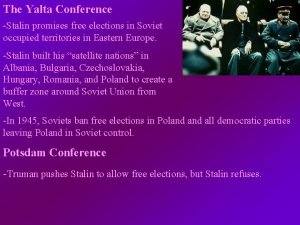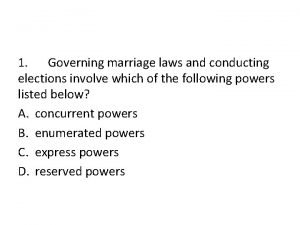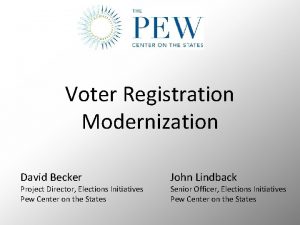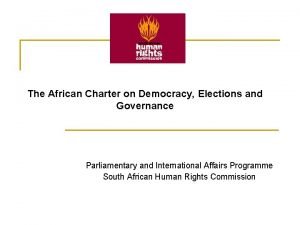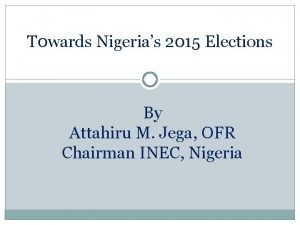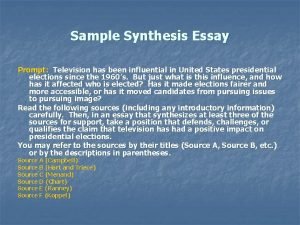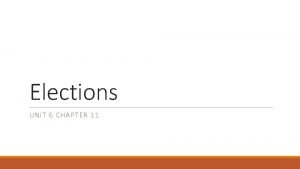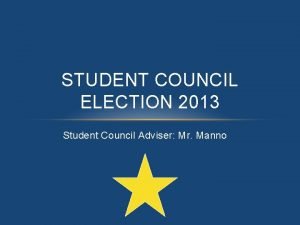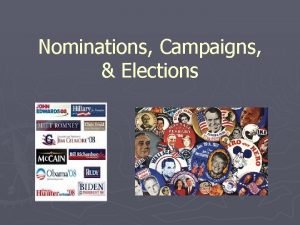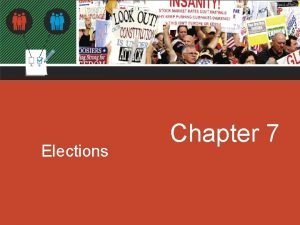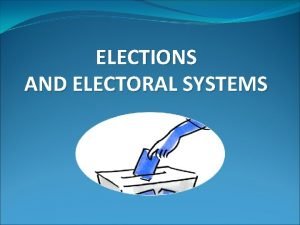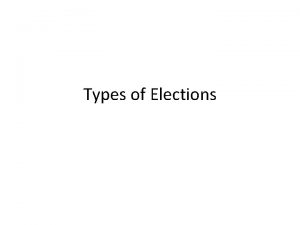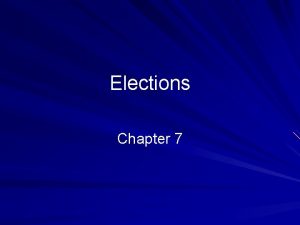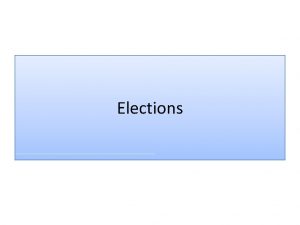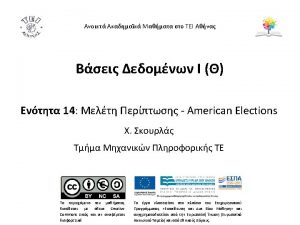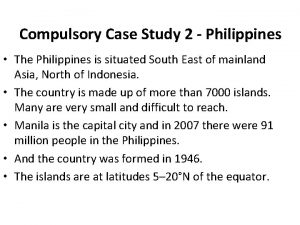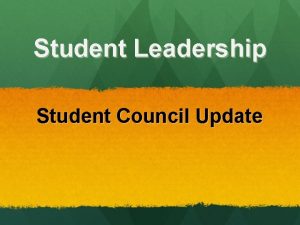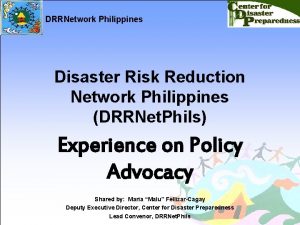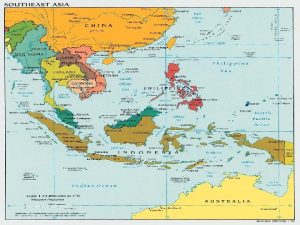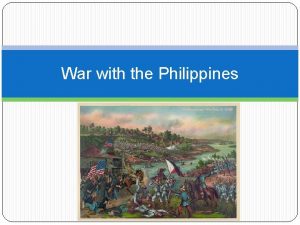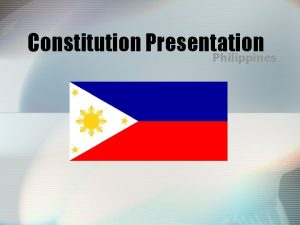STUDENT COUNCIL ELECTIONS A CASE IN THE PHILIPPINES






































- Slides: 38

STUDENT COUNCIL ELECTIONS A CASE IN THE PHILIPPINES PRESENTED IN THE 2017 EROPA INTERNATIONAL CONFERENCE BY ARIUS LAUREN RAPOSAS UNIVERSITY OF THE PHILIPPINES DILIMAN

WHY STUDENT ELECTIONS? “Each student government possesses decision-making powers that outrank those of the board of directors, the PTA, and the faculty. It's a democracy of youth. ” (from Clamp School Detectives)

WHY STUDENT ELECTIONS?

WHY STUDENT ELECTIONS? More than half of the world’s youth live in Asia. By the time the Sustainable Development Goals (SDGs) finish in 2030, the youth will be coming of age.

WHY STUDENT ELECTIONS? “Academic politics is the most vicious and bitter form of politics, because the stakes are so low. ” (Wallace Stanley Sayre)

Nepal India Japan Korea

Indonesia Philippines Myanmar Malaysia

DEMOCRA-KIT • Individuals turned “voters” • Organizations turned “parties” • Candidates turned “representatives”

VOTING AS RITUAL The voter legitimizes the democratic system. Issues are dealt with by the voted.


HOW COME NOBODY WINS? Despite all the glitz and glamor, or noise and clamor, NONE OF THE ABOVE wins student elections.

A CASE IN THE PHILIPPINES ADMU has more than 20, 000 students

A CASE IN THE PHILIPPINES UST has more than 43, 000 students

WHO CARES? Apathy is oft cited as the cause of voting nobody, but what causes apathy?

WHO CARES? Possible causes of apathy: 1. Lacking sense of responsibility (“there are better qualified”) 2. Reliance on others (“someone will do something”) 3. Fear of public judgment (“I will look silly”)

FOCUSING THE RESEARCH The University of the Philippines (UP) has more than 23, 000 students. The Student Council is one of the oldest in the country (1913).

Year 2009* 2010 2011 2012 2013 Turnout 43. 0% 43. 1% 48. 6% 48. 9% 45. 1% Voters 10, 024 9, 728 N/A 11, 532 11, 187 2014 2015 FOCUSING THE RESEARCH 2016 48. 1% 51. 2% 49. 1% 11, 626 12, 578 12, 783 Why UP? None of the above takes 57% of the vote (as of 2017). It’s not yet there, but it’s on the way.



SAME-SAME MENTALITY In the case of the University of the Philippines (UP), it has three political parties. Where do their platforms coincide? 1. Tuition and Other School Fees 2. General Assembly for Organizations 3. Volunteerism 4. Updates for Students 5. Institutional Help for Students 6. School and Job Fairs

SAME-SAME MENTALITY On average, the three parties’ platforms have 60% in common. Eventually, interest in the process drops.

SAME-SAME MENTALITY Stagnant voter turnout = apathy (? ) Possible fourth reason: people are unsatisfied with how issues are being tackled.


YESTERDAY’S FUTURE Our students still live pursuing yesterday's future. Expecting higher turnout alone is not enough. If only we are aiming for a higher voter turnout, then make voting compulsory, but even this is not absolute.

YESTERDAY’S FUTURE Whether they do not vote or abstain, it is a conscious choice.

YESTERDAY’S FUTURE

TOMORROW’S FUTURE Change institutions far becoming obsolete. Give each and every sector of our university a chance to participate.

TOMORROW’S FUTURE Innovation of campaign methods: Operating a LED television for eight hours (US$ 0. 10) Operating a photocopier for one hour (US$ 0. 21) Social media gaining ground: Internet access in PH up from 8. 3% (2009) to 47. 1% (2015) Students becoming more adept in ICT

SMASH THE “MESSIAH COMPLEX” Initiative system: Let students decide and work on the projects they conceive “Leading without position”

THE I IN “TEAM” Shift from institutional help to individual help: • “Selfie generation” – sign of narcissism or of “self-help”

THE I IN “TEAM” Shift from institutional help to individual help: • “Teach them how to fish by giving them fish as an ideal”

TOMORROW’S FUTURE Group of 34 students made to elect one leader and three subleaders thrice: • Before reforms once • After reforms twice Election cycle every five to six months

TOMORROW’S FUTURE Voter turnout: • First election – 38. 2% • Second election – 61. 8% • Third election – 73. 5% Voter demographics: • 16 -19 years old: 23. 5% • 20+ years old: 76. 5%

TOMORROW’S FUTURE There a lot more innovations to explore, and to share. Go for tomorrow’s future!

TOMORROW’S FUTURE There a lot more innovations to explore, and to share. Go for tomorrow’s future!

THANK YOU AND GOD BLESS! CONNECT WITH THE AUTHOR ONLINE: E-MAIL: ARIUS 1998@GMAIL. COM/ACRAPOSAS@UP. EDU. PH FACEBOOK: HTTPS: //WWW. FACEBOOK. COM/ARIUS. RAPOSAS TWITTER: HTTPS: //TWITTER. COM/A_RAPOSAS (@A_RAPOSAS) LINKEDIN: HTTPS: //WWW. LINKEDIN. COM/IN/ARIUS-RAPOSAS/

REFERENCES Photos used in this presentation courtesy to all owners. • Bautista, M. V. , et. al. (Eds. ). (2003). Introduction to Public Administration in the Philippines: A Reader. Quezon City: UP NCPAG. • Berman, E. (2011). Public Administration in Southeast Asia. CRC Press. • Hutchcroft, P. D. , Rocamora, J. (2003). Strong Demands and Weak Institutions: The Origins and Evolution of the Democratic Deficit in the Philippines. In Journal of East Asian Studies 3, 259 -262. • Kavanagh, D. (Ed. ). (1992). Electoral Politics. Clarendon Press. • Naisbitt, J. (1982). Megatrends: Ten New Directions Transforming Our Lives. Grand Central Publishing. • Naisbitt, J. (1996). Megatrends Asia. Nicholas Brealey Publishing Limited. • Naisbitt, J. , Naisbitt, N. , Philips, D. (1999). High Tech/High Touch: Technology and Our Search for Meaning. Nicholas Brealey Publishing Limited. • Navasivayam, S. , Bandhakavi, S. (2012). Leading Without Licence: Leadership the Anna Hazare Way. Rupa and Co. • Raposas, A. (2015). After the domination, the deluge. • Raposas, A. (2016). UP: University to Pioneer or University to Perpetrate. • Raposas, A. (2017). Leaders of Tomorrow: Student Council Elections in UP. • Toffler, A. (1970). Future Shock. Bantam Books. • Toffler, A. (1980). The Third Wave. William Morrow and Company. • Toffler, A. (1990). Powershift: Knowledge, Wealth, and Power at the Edge of the 21 st Century. Bantam Books. • Tomsa, D. , Ufen, A. (2012). Party Politics in Southeast Asia: Clientelism and Electoral Competition in Indonesia, Thailand the Philippines. Routledge. • United Nations Department of Economic and Social Affairs. (2008). Participatory Governance and the Millennium Development Goals (MDGs). New York: United Nations. • Velasco, D. Rejecting “Old-Style” Politics? Youth Participation in the Philippines. PDF.

SAME-SAME MENTALITY The mass is all that which sets no value on itself—good or ill— based on specific grounds, but which feels itself “just like everybody, ” and nevertheless is not concerned about it; is, in fact, quite happy to feel itself as one with everybody else. (Jose Ortega y Gasset)
 Best worst and average case
Best worst and average case Stalin promise free elections
Stalin promise free elections Presidential elections exploration and announcement
Presidential elections exploration and announcement Governing marriage laws and conducting elections
Governing marriage laws and conducting elections David becker elections
David becker elections African charter on democracy, elections and governance
African charter on democracy, elections and governance Conclusion on elections
Conclusion on elections Ap lang synthesis essay television presidential elections
Ap lang synthesis essay television presidential elections “elections are key to democracy”
“elections are key to democracy” What does student council do
What does student council do Sergeant at arms student council
Sergeant at arms student council Expectations for student council
Expectations for student council Student council agenda
Student council agenda Student site council
Student site council What i did last weekend essay
What i did last weekend essay What did they do last weekend
What did they do last weekend National clearinghouse student tracker
National clearinghouse student tracker Class maths student student1 class student string name
Class maths student student1 class student string name National student clearinghouse student tracker
National student clearinghouse student tracker Freckle student login
Freckle student login Hi
Hi Sls learning singapore
Sls learning singapore Hát kết hợp bộ gõ cơ thể
Hát kết hợp bộ gõ cơ thể Ng-html
Ng-html Bổ thể
Bổ thể Tỉ lệ cơ thể trẻ em
Tỉ lệ cơ thể trẻ em Chó sói
Chó sói Tư thế worm breton là gì
Tư thế worm breton là gì Bài hát chúa yêu trần thế alleluia
Bài hát chúa yêu trần thế alleluia Các môn thể thao bắt đầu bằng tiếng bóng
Các môn thể thao bắt đầu bằng tiếng bóng Thế nào là hệ số cao nhất
Thế nào là hệ số cao nhất Các châu lục và đại dương trên thế giới
Các châu lục và đại dương trên thế giới Công thức tiính động năng
Công thức tiính động năng Trời xanh đây là của chúng ta thể thơ
Trời xanh đây là của chúng ta thể thơ Mật thư anh em như thể tay chân
Mật thư anh em như thể tay chân Phép trừ bù
Phép trừ bù độ dài liên kết
độ dài liên kết Các châu lục và đại dương trên thế giới
Các châu lục và đại dương trên thế giới Thơ thất ngôn tứ tuyệt đường luật
Thơ thất ngôn tứ tuyệt đường luật

